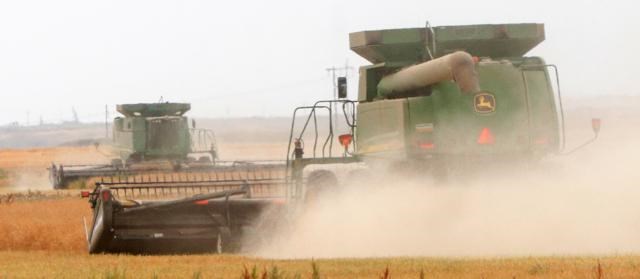Warm, dry weather has helped southeast area farmers to make progress in harvest operations, with 21 per cent of the crops in the bins in the Weyburn region, and 25 per cent of the crops in the Lake Alma-Radville-Minton area.
The southeast as a whole has 19 per cent of the crops combined, plus an additional 16 per cent of the crop swathed or ready to be straight-cut.
This progress is slightly behind the five-year average of 21 per cent for this time of year. Provincially, the harvest is at 15 per cent combined, with an additional 16 per cent swathed or ready to be straight-cut.
The furthest-ahead crops in the southeast include winter wheat, at 82 per cent combined with nine per cent ready to straight combine; fall rye, at 89 per cent combined with four per cent ready to straight combine; barley, at 30 per cent combined with 13 per cent in swath and 13 per cent ready to straight combine; field peas, at 87 per cent combined and five per cent ready to straight combine; and lentils, which is 73 per cent combined and 11 per cent ready to straight combine.
Other crops which are underway include spring wheat, which is 14 per cent combined, 13 per cent ready to straight combine and seven per cent in swath; durum, which is 12 per cent combined with six per cent ready to straight combine and four per cent is in swath; canola, which is four per cent combined with 18 per cent in swath and three per cent is ready to straight combine; mustard, which is seven per cent combined and two per cent in swath; soybeans, which are nine per cent combined, and oats, which are five per cent combined, with 16 per cent swathed and 12 per cent ready to straight combine.
Many areas of the southeast received trace amounts of rain this week, with areas north of Weyburn getting 10 mm.
Warm, dry conditions in most of the region this week depleted topsoil moisture ratings. Cropland topsoil moisture is rated as 46 per cent adequate, 46 per cent short and eight per cent very short.
Hay and pasture land topsoil moisture is rated as 29 per cent adequate, 54 per cent short and 17 per cent very short. Pasture conditions in the region are rated as seven per cent good, 68 per cent fair, 20 per cent poor and five per cent very poor.
The majority of the crop damage this week was due to the lack of moisture, wind and heat, as well as insects like grasshoppers and aphids.
There are concerns about the high fire risk in the region due to the hot, dry conditions.




